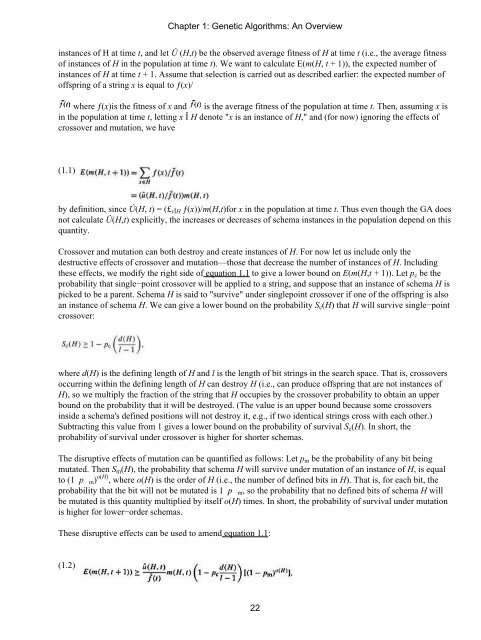An Introduction to Genetic Algorithms - Boente
An Introduction to Genetic Algorithms - Boente
An Introduction to Genetic Algorithms - Boente
Create successful ePaper yourself
Turn your PDF publications into a flip-book with our unique Google optimized e-Paper software.
instances of H at time t, and let Û (H,t) be the observed average fitness of H at time t (i.e., the average fitness<br />
of instances of H in the population at time t). We want <strong>to</strong> calculate E(m(H, t + 1)), the expected number of<br />
instances of H at time t + 1. Assume that selection is carried out as described earlier: the expected number of<br />
offspring of a string x is equal <strong>to</strong> ƒ(x)/<br />
where ƒ(x)is the fitness of x and is the average fitness of the population at time t. Then, assuming x is<br />
in the population at time t, letting x Î H denote "x is an instance of H," and (for now) ignoring the effects of<br />
crossover and mutation, we have<br />
(1.1)<br />
by definition, since Û(H, t) = (£xÎH ƒ(x))/m(H,t)for x in the population at time t. Thus even though the GA does<br />
not calculate Û(H,t) explicitly, the increases or decreases of schema instances in the population depend on this<br />
quantity.<br />
Crossover and mutation can both destroy and create instances of H. For now let us include only the<br />
destructive effects of crossover and mutation—those that decrease the number of instances of H. Including<br />
these effects, we modify the right side of equation 1.1 <strong>to</strong> give a lower bound on E(m(H,t + 1)). Let pc be the<br />
probability that single−point crossover will be applied <strong>to</strong> a string, and suppose that an instance of schema H is<br />
picked <strong>to</strong> be a parent. Schema H is said <strong>to</strong> "survive" under singlepoint crossover if one of the offspring is also<br />
an instance of schema H. We can give a lower bound on the probability Sc(H) that H will survive single−point<br />
crossover:<br />
where d(H) is the defining length of H and l is the length of bit strings in the search space. That is, crossovers<br />
occurring within the defining length of H can destroy H (i.e., can produce offspring that are not instances of<br />
H), so we multiply the fraction of the string that H occupies by the crossover probability <strong>to</strong> obtain an upper<br />
bound on the probability that it will be destroyed. (The value is an upper bound because some crossovers<br />
inside a schema's defined positions will not destroy it, e.g., if two identical strings cross with each other.)<br />
Subtracting this value from 1 gives a lower bound on the probability of survival Sc(H). In short, the<br />
probability of survival under crossover is higher for shorter schemas.<br />
The disruptive effects of mutation can be quantified as follows: Let pm be the probability of any bit being<br />
mutated. Then Sm(H), the probability that schema H will survive under mutation of an instance of H, is equal<br />
<strong>to</strong> (1 p m) o(H) , where o(H) is the order of H (i.e., the number of defined bits in H). That is, for each bit, the<br />
probability that the bit will not be mutated is 1 p m, so the probability that no defined bits of schema H will<br />
be mutated is this quantity multiplied by itself o(H) times. In short, the probability of survival under mutation<br />
is higher for lower−order schemas.<br />
These disruptive effects can be used <strong>to</strong> amend equation 1.1:<br />
(1.2)<br />
Chapter 1: <strong>Genetic</strong> <strong>Algorithms</strong>: <strong>An</strong> Overview<br />
22






